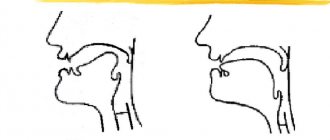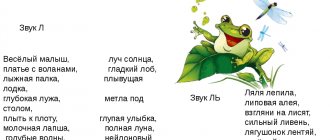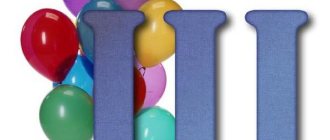Automation of the R sound in adults depends on the severity and cause of the incorrect pronunciation. The correction process differs little from that for children; it includes reading syllables, words, and texts with a problem letter. Anyone can conduct classes independently, at home. When producing sound in children, speech therapists advise using mechanical methods of influencing the articulatory apparatus. When correcting sound in an adult, it is better to adhere to imitative methods. This allows you to find the desired position, position during pronunciation.
Etiology of speech disorder
When pronouncing “R” correctly, the tongue should rise to the palate near the front teeth. This is how vibration appears, which gives this sound. Problems with “R” in adults begin in childhood. The main causes of burr are:
- injuries – defect of the tip or frenulum;
- cervical spine injuries;
- hypoxia during childbirth;
- hydrocephalus;
- intracranial pressure;
- hearing aid disorders;
- inflammatory changes in the hearing aid;
- congenital hearing loss;
- pathologies of phonetic hearing;
- poor bite or missing teeth;
- short bridle;
- paralysis, paresis;
- palate pathologies;
- speech or mental development delays;
- "cleft" lip;
Another reason is the development of a child surrounded by people with impaired hearing and speech. So, from early childhood, the baby hears and gets used to incorrect pronunciation. Burr is not a serious speech therapy disorder; with the help of a course of speech therapy assistance, it is completely corrected.
Thus, four main groups of causes of rotacism can be distinguished:
- Mechanical. Pathologies of the structure of the articulatory apparatus.
- Imitative. The child copies the incorrect pronunciation from the parents.
- Acoustic. Incorrect phonetic perception of the sound “R”.
- Neurological. Pathologies of the speech departments of the human brain.
Before a speech therapist develops a course on how to get rid of burr, it is necessary to accurately determine the cause of its development or appearance.
Types of burr
There are different types of rotacism. Depending on its etiology, there are two types:
- Velar. The vibration occurs at the edge of the soft palate.
- Uvular rotacism. The vibration occurs on the small uvula of the soft palate.
In a broad sense, there are several forms of burr (rhotacism):
- Simple or monomorphic. The pronunciation of one or more sounds of one group is impaired - “S Z C”, “ZH Sh Ch”.
- Polymorphic or complex. The articulation of phonemes from different groups is impaired.
- Physiological. Also called age-related. With it, sound pronunciation is impaired in children under five years of age, which is associated with insufficient development of articulatory organs.
- Functional. Rotacism develops in the absence of problems with the articulatory apparatus, central nervous system, hearing and other devices and systems.
- Mechanical or organic. The development of rhotacism is associated with congenital or acquired pathologies of the speech apparatus.
An accurate diagnosis can only be made by a speech therapist. The definition of burr determines the choice of methods for its correction.
Rotacisms
Correction of burr in adults and children depends on the form of rhotacism. They are as follows:
- There is no “R” in the speech (handle - uchka, river - eka);
- Velar rhotacism or soft pronunciation. The root of the tongue comes into contact with the soft palate, namely its lower edge. A stream of air passes through the gap between them during pronunciation, causing the palate to vibrate.
- Uvular rotacism. Often called "throat".
- Side. The vibration occurs on the side of the tongue, not on the tip. This is how a sound similar to “l” or “rl” appears.
- Bilabial. This type is also called labial, labial or bilabial. Distortion occurs when the lips vibrate, this is how it turns out “prr”. Speech therapists call this sound a coachman's sound.
- Interdental or interdental. Sound pronunciation is caused by the position of the tongue between the teeth.
- Single-strike or proto. Reminds me of “d”, it’s impossible to pronounce the long “RRRRRRRR”.
- Buccal. The exhaled air passes between the cheeks, which causes vibration.
- Nasal. The root is in contact with the soft palate, and air passes through the nose.
- replacing “P” hard with soft.
- Labiodental. The sound is formed between the lip and the upper teeth.
- Laryngeal or laryngeal.
Depending on the form of rotacism, certain exercises are selected aimed at correcting this phenomenon.
Pararotacisms
Pararotacism is the replacement of the rumbling “R” sound with a softer one. The main causes are paresis, short frenulum, impaired phonetic hearing and copying incorrect pronunciation from adults. With pararotacism, the following “P” substitutions occur:
- c: appears in the absence of vibration - “wuka - hand”;
- d: it turns out “hand - duka”;
- g: “hand – guka”;
- n: hand – puka;
- l: hand - bow;
- s: hand – yuka;
- y: hand – yuka.
Correction of pararotacism has many similar sections to burr. The most basic exercise for this is tongue twisters for burr.
Functional burr
Functional burr can develop in a child due to chronic diseases. Another common reason is pedagogical neglect - when a child is given insufficient time from parents and adults, the child develops slowly, not because he has problems with the intellect, but because no one works with him or they do not do it enough.
Often this phenomenon develops in children from bilingual families, that is, adults speak different languages, or from families where one or both parents have such problems. In this way, the child copies the pronunciation of adults. Also, this type of burr may appear due to the presence of disorders of the articulatory apparatus or underdeveloped phonetic hearing.
Organic burr
Occurs due to the structural features of the oral cavity - teeth, bite, tongue (frenulum). A child or adult may burr due to improper jaw structure or lack of teeth. In this case, it is impossible to get rid of rotacism without the help of dentists and an orthodontist. The organic form can appear during life as a result of trauma.
Sensory tongue-tiedness (dyslalia)
This speech disorder is also called tongue-tied or dyslalia. This consists of the inability to pronounce certain sounds or series of sounds. Tongue-tied sounds can be all vowels or all consonants. In the simplest cases, tongue-tiedness affects one or more. Such phonemes are sometimes dropped out or replaced by others. Tongue-tiedness can be called the most common speech defect in a child.
Functional tongue-tiedness is a consequence of improper speech development. It usually occurs at 3-4 years of age and can continue into preschool age. Cases of tongue-tiedness in adults are rare, but they do exist.
How can an adult learn to pronounce the letter r?
The ability not to pronounce the letter P is called burr and brings a lot of inconvenience to both children and adults. Complexes are formed, and, unfortunately, it is impossible to master some professions with a burr. Children are more likely to correct this after visiting a speech therapist, but the question is what to do as an adult. As a person gets older, more work is required to establish correct pronunciation.
The speech apparatus and muscles of an adult are accustomed to a certain pronunciation. Relearning requires a lot of effort and time. But nothing is impossible, what is important is the desire for the best and patience when faced with difficulties. Recognizing the problem is the first step towards solving it, take the following recommendations into account:
- Find some tongue twisters on the Internet. It’s not for nothing that young children are forced to pronounce them in childhood; they train the articulatory apparatus, helping to pronounce sounds. Select about five tongue twisters with frequent use of letters.
- Never avoid words that contain sounds that are difficult for you. You need to fight your complexes, work on your attitude towards the defect. You can hide the pronunciation, but at the same time you will deepen the problem even further into your head.
- Place a mirror in front of you, pronouncing the combinations “la”, “ta”, look at the position of your tongue and lips.
Causes of speech impairment
Burr can be caused by a variety of reasons. This can lead to:
- physical or neurological weakness (occurs with chronic diseases);
- parents do not correct the child’s speech when there are mistakes in it or the child pronounces some sounds incorrectly;
- the child hears incorrect speech from adults and copies it;
- phonetic hearing and sound recognition are not sufficiently developed;
- incorrect articulation;
- pathology of the articulatory apparatus.
Burrs can occur after injuries. This is the main reason for the appearance of such a defect in adults. In some cases, correction of burr in adults cannot be carried out without the help of other specialists.
Mythical and real reasons
In former times, there were many myths about the causes of Jewish burr. There is a legend that the prophet Moses was distinguished by this peculiarity of speech. The Jews considered themselves descendants of this biblical character. They believed that burring was passed down to them from their great ancestor.
According to another legend, this speech trait was given to the Jews by God. It was a kind of gift to the Israelis. Therefore, representatives of the Jewish nation were not only not embarrassed by burr, but were even proud of such speech.
Of course, such explanations have nothing to do with reality. The reasons for burring lie in the peculiarities of the language.
When we start learning foreign languages, sometimes it is difficult for us to pronounce individual sounds. These vowels and consonants simply do not exist in our native speech. And we sometimes replace them with familiar sounds from the Russian language. This is exactly the case with the burrs of the Jews and the French. After all, pronunciation is the most difficult part of mastering foreign languages.
Symptoms of speech impediment
Typical symptoms of burr or rotacism are:
- incorrect pronunciation of hissing and/or whistling sounds – sigmatism;
- difficulty in pronouncing whistling and hissing sounds - parasigmatism;
- pathologies with sonorants [р], [р`], [л], [л`];
- problems with back-lingual phonemes - [g], [g`], [k], [k`], [x], [x`] - gammacism, cappacism and hitism;
- pathology [th] (yotacism);
- replacing voiced consonants with voiceless ones or mixing such phonemes;
- violation of the softness of sounds.
All these manifestations are typical symptoms of burr.
Speech therapy diagnostics
Before prescribing exercises for burr, it is necessary to conduct a detailed speech therapy diagnosis. It begins with a conversation between the child and the specialist. To develop corrective work for rotacism, the speech therapist must determine the following parameters:
- peculiarity of pronunciation of phonemes;
- features of the baby’s psycho-speech development;
- identify defects in sound pronunciation through phonetic analysis;
- assess the condition of the articulation apparatus and identify its defects and pathologies;
- assess the child's vocabulary;
- identify features of writing, grammar, memory, reading;
- determine the level of visual perception;
After these steps are completed, a phonetic hearing assessment is carried out, and then a plan is made to eliminate the burr. In some cases, you will need the help of other specialists - a psychotherapist, a neurologist, a dentist, an otolaryngologist and others.
Is it possible to learn to burr?
Anyone can learn to burr or pronounce the letter “r” in the French or German manner. The main thing is to study and do the exercises.
If you can’t learn to burr at home, you can contact a speech therapist. He will tell you why it doesn’t work and what mistake needs to be corrected.
In extremely rare cases, the problem may be in the structure of the jaw apparatus and the length of the frenulum. A frenulum that is too short may interfere with the correct pronunciation of sounds. A simple dental surgery can correct this physiological problem.
Physiological characteristics do not allow the “r” to burr.
The frenulum is cut under local anesthesia, which takes a couple of minutes. After this, you may experience discomfort for a couple of hours, and then everything will return to normal.
Exercises with a corrected frenulum will be more productive, because nothing else will interfere with you.
Correction methods
There are several methods for correcting burr in adults and children. As the main techniques, the speech therapist uses:
- logomassage;
- exercises to vibrate the front of the tongue;
- tongue twisters starting with the letter “P” from burr;
- classes for automation “R”;
- speech therapy exercises;
- articulation gymnastics;
- speech control.
For the child, the exercises take the form of a game. The main requirement for correcting rotacism is the regularity of these classes.
In children
For children, speech therapists use the following exercises:
- «We brush our teeth." It is necessary to open your mouth wide, smile, make movements reminiscent of brushing your teeth with a brush - movements left and right.
- “We stroke the sky, that is, the palate.” With your mouth open, stroke the palate with your tongue. It should return to the base of the upper jaw.
- "Air battle". Open your mouth, put your tongue on your lower lip and in this state try to pronounce “F”. The escaping air stream should be narrow. This exercise should create a continuous, long stream of air in the middle of the tongue.
- "Sweet tooth." Open your mouth and fix your lower jaw so that it does not move. Lick your upper lip with your wide tongue. It should move from top to bottom. The jaw should not lift it.
- "Turkey". Place your tongue on your lower lip; it should be wide. It is necessary to lick the lower lip back and forth adding voice. A characteristic chattering sound should appear.
- "Drum". Hit the alveoli with your tongue while pronouncing “D”. The mouth should be open.
In teenagers
When working to correct burr in adolescents, basic speech therapy exercises are used. Additional speech therapy exercises are also used:
- A probe (a metal stick similar to a pencil) is placed on the front of the tongue; the tongue must be bent and straightened alternately. The probe must be held in a perpendicular position.
- When performing the “cup” exercise, a pea is placed on the tongue. In this case, the tongue should bend its edges, and the pea should be held on it.
- With your tongue still, turn over the cubes of bread, peas or beans.
- Blow a small piece of paper off your tongue.
- Create a stream of air to vibrate the tip of your tongue. At the same time, a pencil rolls over its surface.
- Massage to strengthen muscles.
You can also get a rolling “R” with the help of exercises for children, pronouncing tongue twisters, of which there are a large number.
In adults
There are some exercises on how to get rid of burr as an adult.
The main cause of burr is incorrect articulation or features of the articulatory apparatus. To make the sound “R”, an adult must perform certain activities at least 2-3 times a day for several weeks. Each lesson lasts approximately 10 minutes. There are exercises aimed at different parts of the articulatory apparatus.
Exercises for the hyoid ligament:
- use the tip of your tongue to reach your nose;
- press the tip to the palate in the area of the roots of the teeth and move it as far back as possible;
- open your mouth, stick out your tongue as much as possible and bend it as high as possible;
- run your tongue along the back of your teeth;
- Fold your tongue into a shovel shape and stick it out as far as possible.
Such exercises are aimed at increasing the elasticity of the hyoid ligament, which is often the cause of this speech disorder.
There are other exercises for the tip of the tongue:
- lightly bite the tip of the tongue;
- press it tightly to the sky, click it;
- stick out your tongue, press it to your lip and in this position exhale air so that vibration appears;
- open your mouth, try to pronounce “D” and “T”.
After mastering the sound, you need to start consolidating, that is, automation:
- The sound “R” is pronounced at first like “T” and “D”, but with the necessary vibration. The tongue should be pressed to the palate, directing a stream of air;
- When vibration is received, you can pronounce “TRRRRR”, “DRRRRR”;
- Connect vowel sounds - “tro”, “dro” and others similar;
- Try to pronounce words with “R”;
- Automate tongue twister skills with this sound.
It is better to increase the effectiveness of these exercises in the mirror. The more often an adult does such activities and the more regularly, the faster this speech disorder will be corrected.
At first, the sound will be more like the growl of a poorly functioning engine. The more and more often you do the exercises, the sooner the letter “P” in speech will become similar to how announcers pronounce it. You can test yourself by recording tongue twisters on a voice recorder (they are now available in almost every mobile phone). If you save these files, you can later track changes in pronunciation.
How can you use the Russian sound “X”?
Indeed, there is an exercise that allows you to achieve a smooth pronunciation of the letter “P” using the Russian sound “X”. After all, these two sounds are very similar in the mechanism of movement of the speech organs.
First you need to find a word with the letter “X” and pronounce it several times in order to understand how the tongue moves at this time. Then play "X" separately. Then try to replace the dull sound with a voiced one. If everything was done correctly, a defective “R” sound will be heard.
Thanks to such simple methods as burring the letter “P”, you can achieve success. The main thing is to do the exercises regularly. At first it will be difficult, as in any educational process. But if you show diligence, you will certainly become burry.
Even if the skill of pronouncing the grazing “R” is acquired, you still should not completely abandon the exercises, especially if you use the correct pronunciation in your normal speech. It is necessary to constantly consolidate the result and improve so that, if necessary, you can dramatically rearrange the articulation of this difficult sound.











